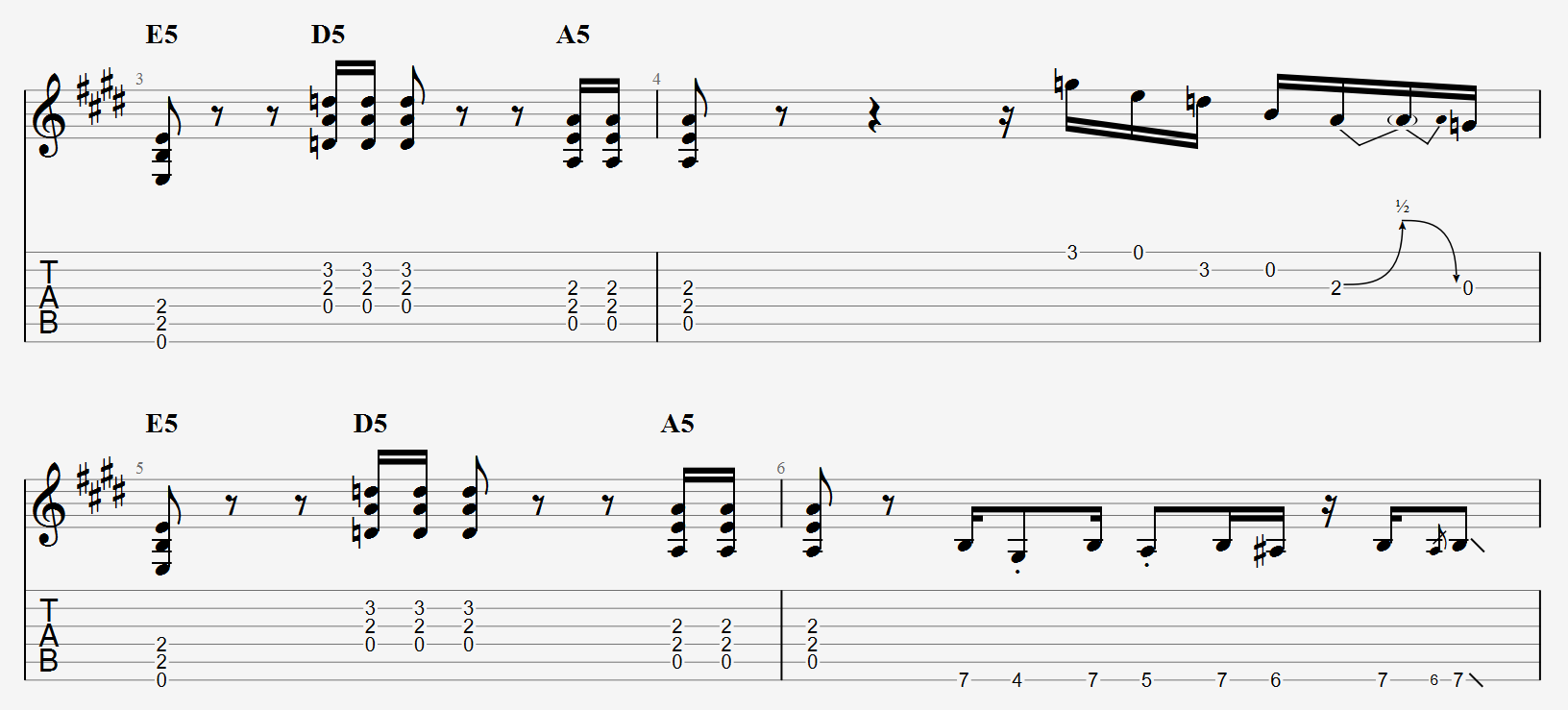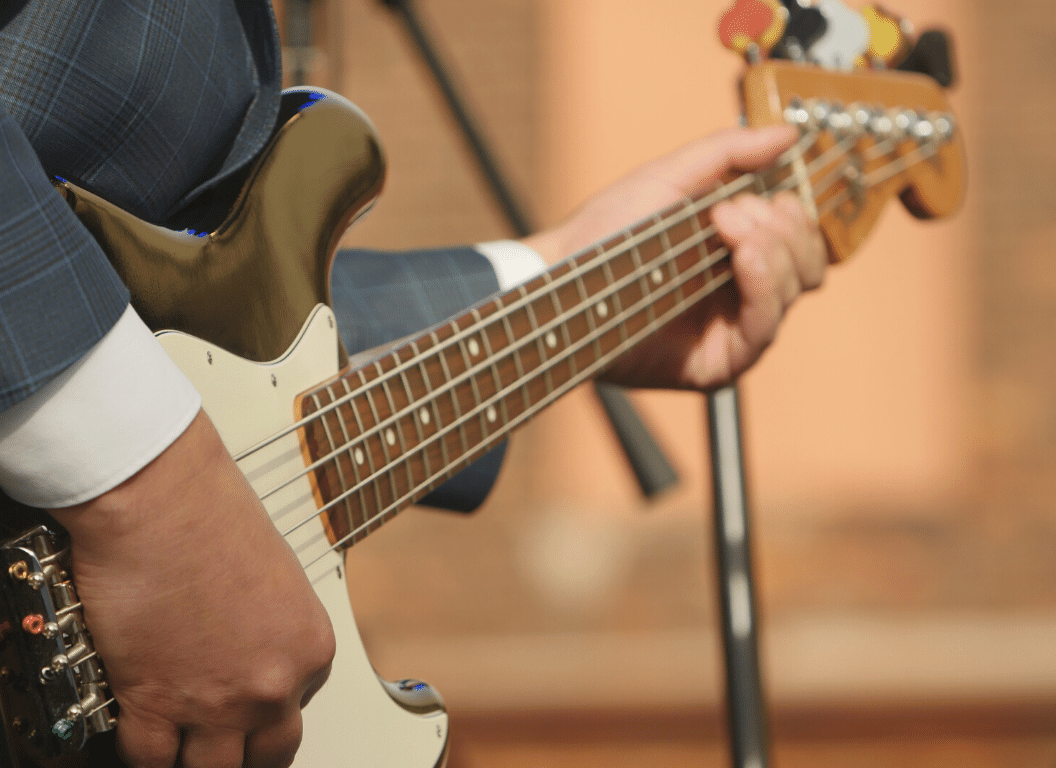Guitarists are always looking for tips, tricks, and techniques that will help them create better guitar riffs.
However, not all methods work the same for everyone!
Somehow, you might have noticed that in music history, some riffs certainly stick more than others, well, what do these riffs have in common? Why do people like them so much?
In this post, I’ll talk about how you can also write good and powerful guitar riffs that are melodic and memorable by just following a few simple tips.
On the other hand, we’ll also go over some of the most frequently asked questions around this topic and list some riffs that have never gotten forgotten throughout the years.
Let’s get started!
Table of Contents
- How to write good guitar riffs?
- 10 Tips For Writing Powerful Riffs
- 1. Mix power chords and licks
- 2. Experiment with different scales and sounds
- 3. Keep your riffs short and to the point
- 4. Use dynamics to create contrast and interest
- 5. Use different picking techniques
- 6. Play octaves to add extra depth to your sound
- 7. Include slides and bends to add extra flair
- 8. Write in the context of a full band
- 9. Add syncopation whenever possible
- 10. Have fun, practice, and be creative!
- What is the difference between a lick and a riff?
- How do you create a catchy riff?
- How do you write riffs with scales?
How to write good guitar riffs?
The quick answer is that what makes a good riff is very subjective to each individual and what they like and don’t like. Now, you can take advantage of dynamics to create contrast and interest, play using different picking techniques, and make sure to keep the riffs short and to the point, and that will usually make most riffs sound much more interesting. Additionally, don’t forget to study, practice, and find new creative ways to be unique and write music!
Now, before we delve into this topic, I want us to be on the same page by defining the terminology that I will be using for the rest of the post.
We’ll define a riff as a short repeated phrase in popular music that’s typically used as an introduction or refrain in a song.
For the sake of this post, we will not consider plain and simple chord progressions as riffs, even though there has always been debate and disagreements among guitarists on whether one is the other, and vice-versa.
10 Tips For Writing Powerful Riffs
Writing those types of riffs that get inside your head and you just remember them all the time is hard but is definitely not impossible.
An essential skill for any guitarist is to be able to do this over and over.
In this section, I’ll share some tips for writing powerful guitar riffs that will make your music stand out.
1. Mix power chords and licks
When writing riffs, don’t be afraid to experiment with different combinations of power chords and licks.
Power chords are the bread and butter of music genres such as rock, but that doesn’t mean you should rely on them exclusively when you’re writing riffs.
Mixing in some well-placed licks can really spice up your riffage and make it more interesting to listen to.
For example, let’s take a listen to AC/DC’s Back In Black:
This song is the perfect example to demonstrate this concept!

The main riff of the song alternates between power chords, with a lick thrown in at the end for good measure.
Without the last part of the riff, it would be much less interesting to listen to.
2. Experiment with different scales and sounds
When you’re writing riffs, don’t be afraid to experiment with different scales and sounds.
For example, if you’re playing in a certain key, you can borrow chords from another scale that will complement the overall sound.
These “borrowed” chords are just chords from the parallel key (minor or major scale with the same tonic).
Borrowed chords are typically used as “color chords”, providing harmonic variety through contrasting scale forms.
For example, let’s say you’re playing in the key of C major.
You could borrow chords from the parallel minor key, which in this case would be C minor.
These chords would add a bit of an emotive quality to your riff since the minor key is generally associated with sadder-sounding music.
On the other hand, if you’re initially writing in a minor key, then adding positive and happy-sounding melodies can add contrast and make it more interesting.
3. Keep your riffs short and to the point
As any musician knows, guitar riffs are the heart and soul of many popular songs.
When writing them, it’s important to also keep them short and to the point.
A lengthy guitar riff can lose its impact after a while, and it’s often better to leave the crowd wanting more.
On the other hand, this will make them more memorable and easier to play, and since shorter riffs are repeated more, they will easily etch themselves into the listener’s brain.
A good example of a short and simple riff that people love can be found in “Smoke On The Water” by Deep Purple.
This song is one of the greatest rock anthems of all time.
It was written in response to the arson attack on the Montreux Casino, which was caught on fire during a Frank Zappa concert.
Deep Purple was staying in the casino at the time of the fire and was forced to evacuate.
The riff was inspired by the sound of the fire trucks that arrived on the scene.
4. Use dynamics to create contrast and interest
One of the most important aspects of writing great guitar riffs is dynamics.
In other words, how loud or quiet your riff is played can have a big impact on its overall feel.
For example, playing a riff very quietly can create a sense of suspense or mystery, while playing it loudly can make it sound more aggressive and in-your-face.
It’s important to use dynamics to create contrast and interest in your riffs, so don’t be afraid to experiment with different volume levels.
This video on the Guitar Control YouTube channel features Robert Baker teaching us how to add dynamics to any riff:
The fascinating thing about this video is that he shows how to do so without changing any note from the original riff.
Simply put, if you have a riff that you’re not a 100% happy with, then this method is perfect for making it better without having to completely change the main idea.
5. Use different picking techniques
Using different picking techniques will create more interesting sounding riffs.
Some of the most popular picking techniques today are:
- Finger Picking: You’d use your fingers to pluck the strings rather than using a pick.
- Alternate Picking: Involves using down and upstrokes alternately to pick the notes.
- Tremolo Picking: Rapidly picking the same note or group of notes over and over again.
- Sweep Picking: Involves using a single down or upstroke to pick each note in succession.
- Economy Picking: Designed to maximize picking efficiency by combining alternate picking and sweep picking.
- Cross Picking: Using a plectrum or flat pick in a rolling, syncopated style across three strings.
- Down Picking: Involves using your fingers to pluck the strings with a downward motion.
- Hybrid Picking: Combines both fingerstyle and plectrum playing.
By experimenting and switching between these picking techniques you’ll be able to create some really cool-sounding guitar riffs.
Aside from that, you can utilize different rhythms and forms such as playing accented notes on the beat or off the beat which will also keep your riffs sounding fresh and unique.
6. Play octaves to add extra depth to your sound
Playing octaves is a great way to add extra depth and interest to your guitar riffs and will give them a fuller sound and make them more powerful.
When playing octaves, you can either play them on one string by sliding from one note to the other or spread them out over two strings at the same time.
This YouTube video is one of the best resources online that clearly demonstrates this concept:
In one of our previous points, I mentioned how you should mix power chords and licks, so in this case, you would be adding more originality to those same licks by doing this.
7. Include slides and bends to add extra flair
One way to add extra interest and flair to your guitar riffs is to use slides and bends.
A slide is simply when you slide your finger up or down the fretboard, changing the pitch of the note.
This can create a smooth, gliding sound that can add a lot of emotion to a riff, which for emotional melodies and songs, is perfect.
A bend, on the other hand, is when you push or pull the string away from the fretboard, causing the pitch to rise or fall.
This can be used for dramatic effect, especially when combined with vibrato (which is when you rapidly move your finger back and forth on the string).
By using slides and bends, you can add a lot of personality to your guitar riffs, since these techniques, especially bend, require a certain degree of intuition and force that only the player has full control over.
8. Write in the context of a full band
Yes, a good riff is essential to writing a great song, but what many guitarists don’t realize is that the context in which you play your riffs is just as important as the riffs themselves.
When you’re jamming with a full band, it’s important to write riffs that complement the other instruments and create a cohesive sound.
That means using space wisely and thinking about how your riffs will interact with the drums, bass, and vocals.
Pay attention to the overall rhythm of the song and make sure your riffs fit within that framework.
By considering the full band when you’re writing guitar parts, you can take your songs to the next level since you’ll add just the right amount of presence to complement the other instruments.
“Don’t Wanna Fight” by Alabama Shakes is a great example of a song with a guitar riff that seats perfectly with all the other instruments:
Alabama Shakes is an American blues rock band formed in Athens, Alabama, in 2009; the group rose to national prominence in early 2012 with the release of their critically acclaimed debut album Boys & Girls.
You can hear in this song how the guitar is not only the lead instrument but also the primary source of rhythm, but at the same time, is not so loud that you can’t hear the other instruments playing supporting roles.
The band’s use of dynamics is what makes this song so interesting; it starts out with a relatively simple guitar riff, but as the song progresses, more and more instruments are layered in, giving the song a fuller sound.
9. Add syncopation whenever possible
Syncopation is a musical term used to describe when the beat is divided up into unequal parts, creating a sense of off-kilter rhythm.
Essentially, syncopation occurs when the stresses or accents in the music fall on areas other than the normal beats.
For guitarists, syncopation can be a great tool for adding interest and excitement to their riffs!
When used tastefully, syncopation can add an element of groove and swing to a riff, making it more infectious and memorable.
However, it’s important to use syncopation sparingly, as too much of it can sound cluttered and busy.
By simply adding a few well-placed accents, you can give your guitar riffs more punch and personality. So
10. Have fun, practice, and be creative!
In the end, the best way to write good riffs is to have fun, be creative, and play as much as possible.
In genres where guitars are used more than other instruments, musicians tend to come up with their best ideas whenever they’re not looking for them.
It happens all the time, especially if you play with a band!
Rarely somebody has ever said, “let me sit down and write a hit” and has actually done it; there are no rules when it comes to writing new music, so experiment and see what sounds good to you.
With practice, you’ll develop your own style and instinct for finding little riffs that come naturally to you when you’re playing the guitar, and you’ll turn them into full songs.
What is the difference between a lick and a riff?
In music, a lick is a short phrase that is usually repeated or extended.
Licks can be created by improvisation or composed ahead of time, but generally, they’re just small ideas that can be easily integrated into a larger piece of music.
Riffs, on the other hand, are usually longer and more complex than licks.
They often form the basis of a song, serving as both the melody and the accompaniment.
While riffs can be used in a variety of genres, licks tend to most commonly be associated with rock and blues.
Although both licks and riffs are important components of guitar playing, they serve different purposes and have different effects on the overall sound of the song.
How do you create a catchy riff?
A catchy riff is the backbone of any great song (let it be pop, rock, metal, etc.), and there are a few simple things you can do to make sure your riff stands out.
Most importantly, use repetition to your advantage, think Sweet Child O’ Mine by Guns N’ Roses.
A simple, catchy melody will stay in a listener’s head much longer than a complex one, and the reason why shorter riffs stick more than longer ones is simply that they’re easier to remember.
Now, digging a little further, the word “catchy”, according to Oxford Languages, means:
(of a tune or phrase) instantly appealing and memorable.
So, if you listen to a riff for the first time today, and then a day or two later, without having to play it or listen to it again, you can kind of hear it in your head, then that was a memorable riff.
Harvard published a great resource around this topic in an article titled: Why you can’t get a song out of your head and what to do about it.
Apparently, when you can’t get a song out of your head, this is also known as “earworms”.
What they found was that “these songs were faster and simpler in melodic contour” (the pitch rose and fell in ways that made them easier to sing).
And the music also had some unique intervals between notes that made the song stand out.
This means playing unexpected notes and variations of what the audience might have thought that was going to happen in the first place.
How do you write riffs with scales?
To write riffs with scales, you’ll need to understand how scales and chords are related.
Scales are simply groups of notes that sound good together, while chords are built from a scale by selecting certain notes.
The most important thing to remember is that each scale has its own unique sound, so you’ll need to experiment to find the one that fits your song.
Once you’ve found the right scale, you can start writing riffs by improvising or using a notebook to jot down ideas.
The key is to find a balance between catchy melodies and interesting harmony.
By using both scalar and chordal elements, you can create riffs that are both memorable and musically rich.
If you want a place to start, check out our resources on guitar scales in which we show you how notes, chords, and scales are related, and how you can use that information to create and compose songs.

More than 10 years of experience playing and writing about guitars! When not writing, I can be found strumming away some Johnny Cash tunes. Favorite all time guitar is the Gibson Les Paul. #TeamGibson




